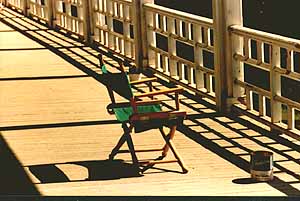
WAWONA
JOURNAL
by TOM BOPP
April 22, 2004
Tom addresses the Interior Secretary
Tom was invited by Yosemite Superintendent Mike Tollefson to give a 10-minute talk to then Interior Secretary Gail Norton while she lunched in the Sun Room at the Wawona Hotel. Here's the transcript -- a brief history of the hotel and a word about preservation.
Transcript of talk at the Sun Room,
Here we are in the “Sunroom”—in the
newest building on the Wawona grounds—Arts & Crafts
style—opened in 1918. Actually,
if one guy had gotten his way back in the ‘20s, we’d be standing
in a lake—“
Albert Gordon’s lived here all his life—he’s in his 80s—back in the ‘50s—in the winter when the hotel was closed—Albert was frantically putting out a fire over in the main building; a now-forgotten executive saw him and said “why are you bothering?”[i] It’s amazing to me that this place is still standing—thank goodness—and now finally we’re replacing the foundations!
9,000 years ago—according to local
Indians—9,000 years ago the first people lived in the
Having seen this area, I guess Galen decides it’s as good a place as any to die, so the next year—1856—he takes out a pre-emption claim on 160 acres right here, and the year after that in April he builds a cabin out front of where the Wawona Hotel now stands. Of course, the local Indians are keeping a close eye on him, but he gets along with them well enough.
Since Galen’s new little cabin was right next
to the new toll-trail into Yosemite, he immediately began offering
room and board to tourists, and,
by gosh, we’ve been in business ever since!
Every year more tourists came through, so
And you’ll notice he’s failing to live up
to his doctor’s bleak prognosis – it’s 1864 and Galen’s still
failing to die, so they make him Guardian of the newly protected
Yosemite Valley and the Mariposa Grove of big trees – the same
trees that he and a friend discovered back in ‘57.
Clark’s got plenty of business at his hotel, called
Clark’s Station, but isn’t charging enough for room and board,
and is always making dumb investments and by 1874 he’s just in
debt up to his eyeballs—$20,000.
Enter Henry Washburn, who’s making all kinds of money
bringing in tourists on horseback.
So Washburn buys out
So, Henry Washburn’s in charge: with his business partners he adds buildings (including the main one—we’re celebrating its 125th birthday this year[iii]); Henry builds the road from here to Yosemite Valley, expands his horse-stage business, schmoozes investors… his brother John Washburn runs the hotel complex, and his brother Ed Washburn is the book-keeper – these are the three youngest of 15 brothers – 15 boys…by two mothers; the first one died, understandably—all from Putney, Vermont.
Time marches on—John Washburn dies in 1917, and his son Clarence Washburn inherits control of the business – it’s a corporation by now, and Clarence is the majority stockholder. Clarence built up the business to what we see today – he put in the golf course, tennis court, pool, new fountain, and this building – all around 1918. And he decided in 1930 to sell.
The hotel company owned over 3,000 acres here
– at that time, Wawona wasn’t part of
So here we are, and we’re not
standing in a lake or a subdivision, we’re here in a place that
the Indians called Pallahchun, which means “a good place to
stop.” And it still
is—this place has been a way-station for thousands of years.
And this building is one of
The mission statement of the NPS has a built-in
paradox; it says we’re supposed to preserve “unimpaired
the natural and cultural
resources … of the National Park System.”
Buildings like this one, the 1879 Yosemite Chapel, and the
1904 Le Conte Memorial in
100 years ago somebody named Robinson
petitioned the Yosemite Commissioners to let him build a resort
hotel in the
One lesson you could get from this is: The
more stuff we build in
Well,
no. But the thing
is, we bring culture with us to Yosemite just as naturally as birds
bring their singing—and remember: we’re indigenous, so
maybe—just like a bird’s nest in a giant sequoia—just maybe
this building is a natural
as well as a cultural resource.
It’s right there in the Park Service’s mission statement:
cultural and natural
resources are so intertwined that we’re supposed to protect both—unimpaired.
Our cultural heritage and values are so essential to the way
we run
Having worked here for over 20 years, I’m
really happy to see the partnership of the Park Service and Delaware
North to save these structures that have played such a vital role in
preserving
[i] Albert Gordon died in 2005 at age 86
[ii] Facts in this and the preceding paragraph were updated in 2006 to reflect my current research discoveries.
[iii]
In 2004 we celebrated what was called by the marketing department
“The Wawona Hotel 125th Anniversary.” Trouble is,
it was only the anniversary of the
[iv] I have not verified this story with primary sources, but have it on good authority – I intend to check it later.
[v]
This story was told by former Yosemite Superintendent Horace
Albright, quoted in “